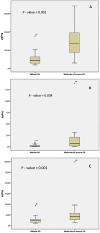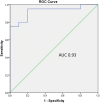Establishment of a tear protein biomarker panel differentiating between Graves' disease with or without orbitopathy
- PMID: 28419103
- PMCID: PMC5395154
- DOI: 10.1371/journal.pone.0175274
Establishment of a tear protein biomarker panel differentiating between Graves' disease with or without orbitopathy
Abstract
Background: Graves' orbitopathy (GO) is an autoimmune inflammatory ocular complication and one of the most frequent manifestations of Graves' disease (GD). Clinical judgment of GO is subjective sometimes leading to clinical and therapeutic challenges. Better tools to diagnose this severe complication are warranted.
Patients and methods: The aim of the present study was to evaluate tear levels of LYZ, LACRT and AZGP1 in GD patients with or without GO, as possible biomarkers for GO. Tear samples were collected from GD patients with moderate-to-severe GO (n = 21) and no clinical signs of GO (n = 21). Additionally, 18 GD patients with mild GO and 9 patients without GO were included in a further part of the study.
Results: Tear levels of LYZ (p < 0.001), LACRT (p = 0.004) and AZGP1 (p = 0.001) were significantly elevated in GD patients with moderate-to-severe GO compared to GD patients without GO. The discriminatory power of the three biomarkers, combined in a panel was confirmed by ROC plot analysis, with an AUC value of 0.93 (sensitivity of 95%; specificity of 80%). Since LYZ showed the best performance in discriminating between GD patients with (moderate-to-severe) and without GO (in combination with limited sample volume available), LYZ levels were also measured in tears from GD patients with mild GO and without GO. Significantly higher levels of LYZ were measured in GD patients with mild GO compared to those without GO (p = 0.003).
Conclusions: We have established a novel three-protein biomarker panel that is able to discriminate between GD patients with and without GO, which might aid in diagnostic evaluation of GO as well as an indicator for disease activity.
Conflict of interest statement
Figures



Similar articles
-
Tears as a Source of Biomarkers in the Diagnosis of Graves' Orbitopathy.Biomolecules. 2022 Nov 2;12(11):1620. doi: 10.3390/biom12111620. Biomolecules. 2022. PMID: 36358969 Free PMC article. Review.
-
Graves' orbitopathy results in profound changes in tear composition: a study of plasminogen activator inhibitor-1 and seven cytokines.Thyroid. 2012 Apr;22(4):407-14. doi: 10.1089/thy.2011.0248. Epub 2012 Mar 2. Thyroid. 2012. PMID: 22385289
-
Comparative proteomic analysis of tear fluid in Graves' disease with and without orbitopathy.Clin Endocrinol (Oxf). 2016 Nov;85(5):805-812. doi: 10.1111/cen.13122. Epub 2016 Jul 1. Clin Endocrinol (Oxf). 2016. PMID: 27256639
-
Ocular surface disease index in Graves' orbitopathy: a cross-sectional study.Front Endocrinol (Lausanne). 2024 Dec 5;15:1428185. doi: 10.3389/fendo.2024.1428185. eCollection 2024. Front Endocrinol (Lausanne). 2024. PMID: 39713053 Free PMC article.
-
A systematic review of multimodal clinical biomarkers in the management of thyroid eye disease.Rev Endocr Metab Disord. 2022 Jun;23(3):541-567. doi: 10.1007/s11154-021-09702-9. Epub 2022 Jan 23. Rev Endocr Metab Disord. 2022. PMID: 35066781
Cited by
-
Molecular Biomarkers in Thyroid Eye Disease: A Literature Review.Ophthalmic Plast Reconstr Surg. 2023 Dec 1;39(6S):S19-S28. doi: 10.1097/IOP.0000000000002466. Epub 2023 Dec 4. Ophthalmic Plast Reconstr Surg. 2023. PMID: 38054982 Free PMC article. Review.
-
Tears as a Source of Biomarkers in the Diagnosis of Graves' Orbitopathy.Biomolecules. 2022 Nov 2;12(11):1620. doi: 10.3390/biom12111620. Biomolecules. 2022. PMID: 36358969 Free PMC article. Review.
-
Ocular surface changes in Graves' ophthalmopathy.Int J Ophthalmol. 2021 Apr 18;14(4):616-621. doi: 10.18240/ijo.2021.04.20. eCollection 2021. Int J Ophthalmol. 2021. PMID: 33875956 Free PMC article. Review.
-
Evaluation of tear and serum clusterin levels in thyroid ophthalmopathy patients.Int Ophthalmol. 2025 Mar 22;45(1):117. doi: 10.1007/s10792-025-03501-w. Int Ophthalmol. 2025. PMID: 40119947
-
The potential of tear proteomics for diagnosis and management of orbital inflammatory disorders including Graves' ophthalmopathy.Exp Eye Res. 2021 Dec;213:108813. doi: 10.1016/j.exer.2021.108813. Epub 2021 Nov 3. Exp Eye Res. 2021. PMID: 34742692 Free PMC article. Review.
References
-
- Perros P, Crombie AL, Matthews JNS, Kendall-Taylor P. Age and gender influence the severity of thyroid-associated ophthalmopathy: a study of 101 patients attending a combined thyroid-eye clinic. Clin Endocrinol. 1993; 38: 367–372. - PubMed
MeSH terms
Substances
LinkOut - more resources
Full Text Sources
Other Literature Sources
Medical
Molecular Biology Databases
Miscellaneous

